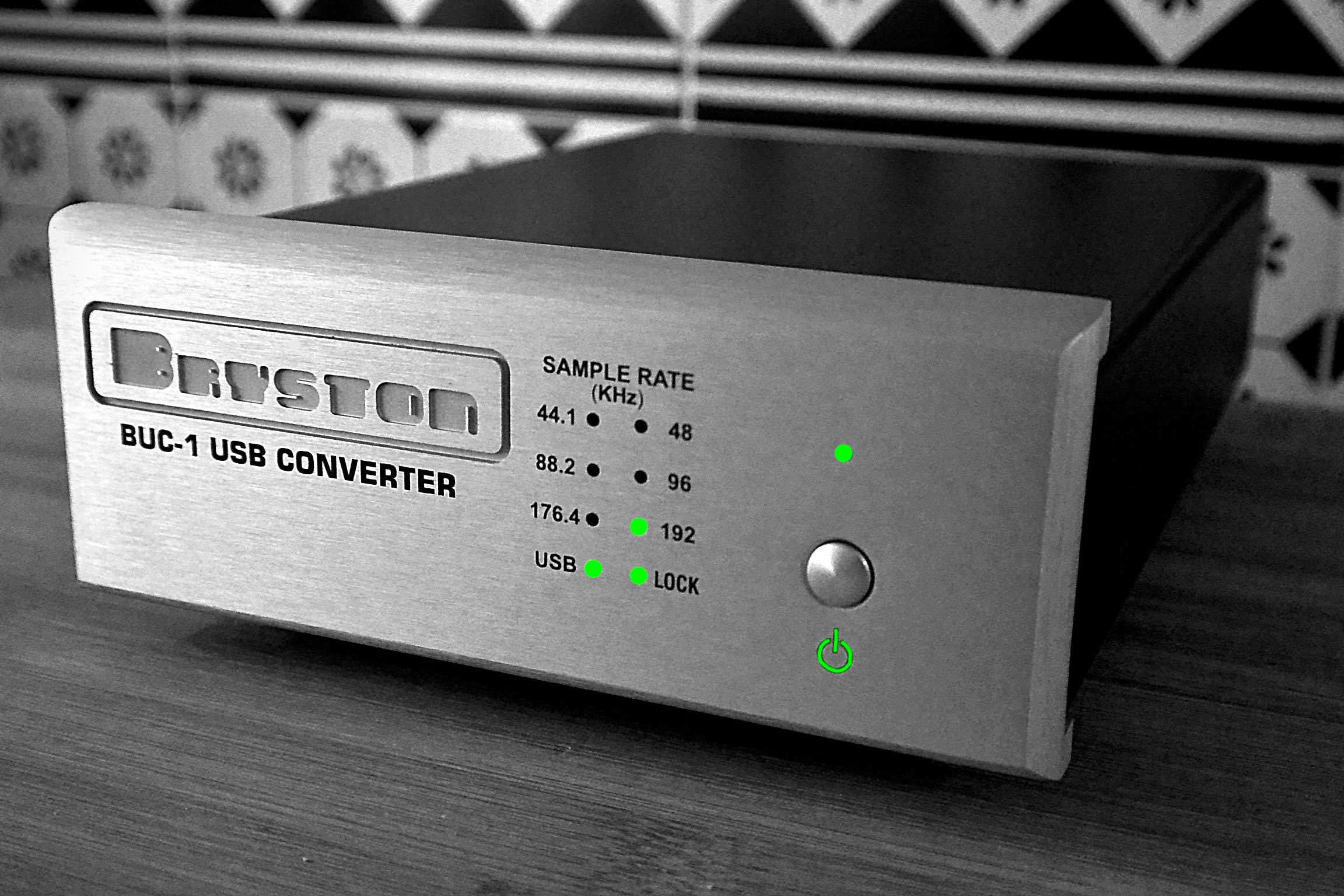Bryston BUC-1
USB digital audio signal interface review


Introduction
Liquid music, a term that has become common use, is spreading like wildfire. The use of high resolution audio files is in fact attracting an increasing number of fans and listeners, and not necessarily occasional ones. Users have begun to use the computer as a primary source for playback and listening to their music.
This new phenomenon has given birth to and seen the rise of marketing of a whole range of specific equipment, some of which offers rather sophisticated technical solutions that allow you to interface the PC with your stereo system, using the now widespread and common USB port. However, to achieve the so-called nirvana of music playback through the USB port some rules should be observed. For example: the use of a USB cable which requires the separation of the power signal from audio data; the use of a dedicated power supply for the USB signal; and last but not least, the choice of a correct interface or USB converter. In this regard, we are referring in particular to the device which is the object of this review, the asynchronous USB converter called BUC-1 made by Bryston. Bryston, a Canadian company devoted to the creation of high-end audio equipment also for professionals, is among those who have entered into this segment of the market by offering an interface that allows you to convert the USB signal into common digital formats such as AES/EBU and S/PDIF. Thereby giving users both the possibility to transform the simple USB signal into a PCM digital audio signal that can be easily decoded by different professional or consumer audio equipment and enable the USB interface to manage the transfer of the audio data using the USB 2.0 protocol. This in turn allows the BUC-1 to act as the master to regenerate the clock signal and filter any possible EMI noise. Achieving both of these goals has allowed Bryston to create a product such as the BUC-1.
Design

The BUC-1 is essentially an interface that allows you to convert the USB audio signal from a PC into a digital PCM AES/EBU and S/PDIF audio signal. It’s well made and its design is simple but attractive as well as being quite small. Its weight gives you the clear impression of being a solid and well made device with a metal exterior chassis. The front panel, which at the customer’s request can also be black or silver, is made of brushed metal. On it are located both the power button and a set of lights with 8 small green LEDs indicating the sampling frequency of the input signal, the presence or absence of the USB connection and the locking of the clock signal by the BUC-1. The rear panel, in addition to the IEC socket to connect the power cable, is equipped with a balanced XLR socket for the digital AES/EBU signal, two coaxial connectors and one BNC for the S/PDIF signal. Inside the BUC-1, we find a latest generation XMOS chip for USB signal decoding. This chip is able to accept PCM audio streams of up to 24/192 kHz and DoP (DSD over PCM) of up to 2.8 MHz. There are also two low phase noise high quality clocks, one for multiples of 44.1 kHz and the other for multiples of 48 kHz. Bryston has also provided the BUC-1, with a properly dimensioned power supply with the function of removing all the noise generated by the computer (motherboard, hard disk, etc.), and a multistage filter to eliminate electromagnetic interference noise both of which cause the most damage to the overall quality of sound reproduction in the USB chain. The internal power supply is stabilized and also provides power to both the clocks and the digital circuit. Other features included are the power cord, a printed manual and a USB stick with the drivers needed by Windows users as the Apple operating system automatically recognises the BUC-1 without the need for drivers. Overall, every detail has been carefully designed to achieve the best result.
Listening test

As usual in all of our listening tests, we let the machine burn in for at least 48 hours. We then replaced the power cord with a more sophisticated one in order to enable the BUC-1 to unleash its full potential. Once the burn in process was completed we proceeded without any difficulty, to install on our Windows DAW, the drivers required to use the USB converter. The songs used for the listening tests have been high-resolution recordings, which are more suitable to exploit in depth all the technical capabilities offered by the BUC-1. When comparing the product of Bryston with another interface we use, produced by Audio Matrix, we were able to detect clear differences. When trying to describe them, the first word that comes to mind as regards the performance of the BUC-1 is naturalness. Music playback is effortless with all the instruments played in a very realistic manner and utterly devoid of any sense of artifice typical with a digital audio signal. The accuracy of the details and the focus is really good as well as the articulation of transients. Compared to the X-SPDIF by Matrix Audio, the BUC-1 appears to further extend the response of the source to the extremes of the sound spectrum. The low-frequencies gain in extension and the highs are more precise. We can clearly hear a greater separation of channels and what has struck us, as well as the purity of the sound message, is the dynamics of the music. The instruments acquire greater weight and impact allowing them to lash out even more clearly through our playback chain.
The BUC-1 is a device that doesn’t take away or add anything to the source. Its tonal balance makes it look like it was completely transparent in extolling the merits or demerits of the recordings. Out of curiosity we also wanted to include the iPurifier filter between the USB cable and the USB input of the BUC-1 to verify whether the sonic performance of the device could in some way be affected positively or negatively. In all honesty we only saw a slight improvement in sound performance as regards focus and articulation of transients but the perceived improvements were modest to the point that the use of the iPurifier proved not to be decisive. All this was due to the benefits of the high quality construction of the internal power supply and filtering circuits of the BUC-1. Finally, we wanted to compare the possible sonic differences between the AES/EBU balanced digital output and the coaxial S/PDIF output. When switching quickly between one connection and the other, the AES/EBU balanced digital output was the one that gave us the best performance and the one that convinced us most as regards the excellent performance of this USB interface. The coaxial output ensures an excellent quality but certainly doesn’t have the same weight, soundstage size, naturalness and articulation of the balanced digital one. Although it goes without saying that the best yield of the BUC-1 is obtained with original recordings at 96 and 192 kHz, common audio files with original CD resolution are certainly not to be underestimated.
Final thoughts

The BUC-1 is definitely a device that has been positively influenced by all the know-how acquired by Bryston over the years in the field of digital audio. We could easily consider it a professional piece of gear created for the consumer market in order to offer, even a normal user, the best performance from his USB audio chain. Although unlike some of its competitors it can’t decode formats such as DSD, DXD or the PCM audio files with a resolution of 352 and 384 kHz, the BUC-1 shows naturalness, dynamics and neutrality all of which are its’ greatest strengths. It’s a product that should be seriously considered by all those of you who don’t own a DAC with a USB input or whose USB input is limited to 96 kHz, in order to get the best in sonic reproduction from your audio chain. In conclusion, it must be said bluntly and without fear of venturing into absolutistic claims that the BUC-1 made by Bryston can make a difference as long as the rest of the playback chain is up to it. It definitely has our highest recommendation. Well done Bryston!
Personal opinion

If in the beginning I had any doubts that a different USB interface could somehow improve the sonic performance of my audio chain, I ended up changing my mind. I rediscovered the listening of a lot of songs I already knew very well, and above all, thanks to the BUC-1, I had a much clearer and more precise picture of what was coming from the source. I’ve always loved devices that don’t colour or alter the sound message, and that above all highlight in a merciless way all its strengths and weaknesses. Bryston’s BUC-1 has done this perfectly thereby becoming my new reference product. Therefore, I would highly recommend it to any fan that uses a computer as the main source for listening to music.
Score
- Scoring110
- Sound quality [1]
10 - Bang fot the buck [2]
9 - Measures [3]
10 - Build quality [4]
10 - Versatility [5]
8 - Overall rating
9
- 1. The sound quality is really excellent especially with high resolution tracks
- 2. The bang for the buck of the device is very good
- 3. The measurements show an excellent linearity on various parameters
- 4. Build quality and aesthetics are excellent
- 5. Versatility is wide-ranging but only limited to PCM files up to 192 kHz








